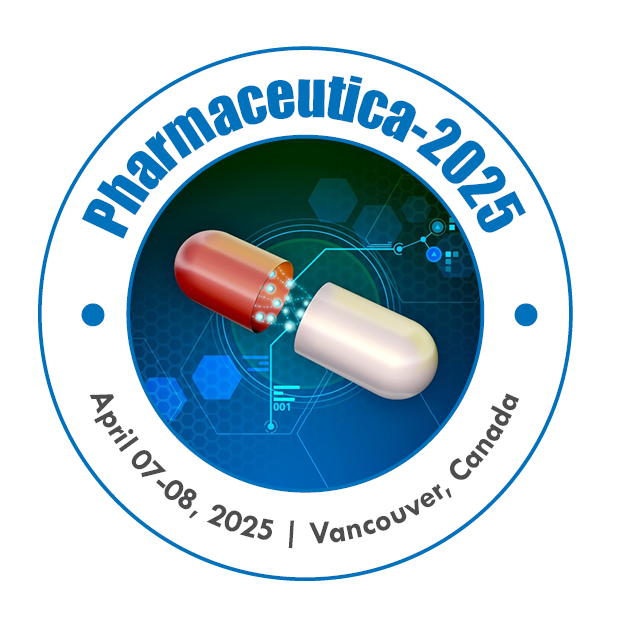Session and Tracks
Track 1 : Advancements in Drug Delivery Systems
Advancements in drug delivery systems are revolutionizing the pharmaceutical industry by enhancing the efficiency, specificity, and convenience of drug administration. These innovations are aimed at improving patient outcomes, minimizing side effects, and ensuring that medications are delivered at the right time and place within the body. Developing drug delivery mechanisms that can precisely target diseased cells or tissues, thereby reducing systemic exposure and minimizing side effects. Controlled release systems ensure that drugs are released at a specific rate and duration, improving therapeutic outcomes. Utilizing nanoparticles to deliver drugs directly to specific cells or tissues. Nanoparticles can cross biological barriers, such as the blood-brain barrier, and provide a high degree of control over drug release profiles. Designing drug carriers made from biodegradable polymers that safely break down in the body, reducing the need for surgical removal and minimizing long-term side effects.Developing systems that respond to specific physiological triggers, such as pH changes, temperature, or specific enzymes, to release drugs in a controlled manner.
Track 2 : Pharmacokinetics and Pharmacodynamics
Pharmacokinetics and pharmacodynamics are fundamental concepts in the field of pharmacology, critical for understanding how drugs work within the body and how they produce their effects. These areas provide insights into the drug's behavior, efficacy, and safety, which are essential for drug development, dosing regimens, and therapeutic strategies. The process by which a drug enters the bloodstream from its site of administration. Factors affecting absorption include the drug's formulation, the route of administration (oral, intravenous, transdermal, etc.), and physiological conditions like gastrointestinal pH and motility. The dispersion of the drug throughout the body's fluids and tissues. Distribution is influenced by factors such as blood flow, tissue permeability, and the binding of the drug to plasma proteins and tissues. The biochemical transformation of the drug, primarily in the liver, into metabolites. This process can activate or inactivate the drug and is influenced by factors such as enzyme activity, genetic variations, and the presence of other drugs. he removal of the drug and its metabolites from the body, primarily through the kidneys (urine) and liver (bile). Factors affecting excretion include renal function, urinary pH, and the drug's chemical properties.
Track 3 : Biopharmaceutics and Drug Disposition
Biopharmaceutics and drug disposition are critical fields within pharmaceutical sciences that focus on the drug's journey from its formulation to its eventual action within the body and its elimination. These areas encompass the study of drug absorption, distribution, metabolism, and excretion (ADME), as well as the impact of formulation on drug performance. Biopharmaceutics examines how the physical and chemical properties of drugs, the formulation, and the route of administration influence the rate and extent of drug absorption into the bloodstream. The design and composition of the drug product, including the active pharmaceutical ingredient (API) and excipients. Formulation affects the drug's stability, solubility, and release rate. The path by which a drug is taken into the body, such as oral, intravenous, intramuscular, transdermal, or inhalational. Each route has distinct absorption characteristics and bioavailability. The process by which the drug dissolves in bodily fluids, impacting its absorption. Enhancing solubility can improve bioavailability, especially for poorly soluble drugs.
Track 4 : Novel Drug Delivery Technologies
The development of novel drug delivery technologies has revolutionized the pharmaceutical industry, offering innovative methods to enhance the efficacy, safety, and patient compliance of therapeutic treatments. These technologies aim to deliver drugs more precisely to target sites, control the release rates, and improve the bioavailability of active pharmaceutical ingredients. Nanoparticles, including liposomes, dendrimers, and polymeric nanoparticles, offer significant advantages in drug delivery due to their small size, large surface area, and ability to be engineered for targeted delivery. They can improve drug solubility, stability, and provide controlled release profiles. Spherical vesicles with lipid bilayers, ideal for delivering both hydrophilic and lipophilic drugs. They protect drugs from degradation and can be modified for targeted delivery. Made from biodegradable polymers, these carriers can encapsulate drugs and provide sustained release. Branched, tree-like structures that can carry multiple drug molecules and target specific cells or tissues. These small spherical particles are used for controlled and sustained drug release. Made from biocompatible materials, they can encapsulate drugs and protect them from harsh biological environments. Transdermal patches and gels allow drugs to be absorbed through the skin, providing a non-invasive and controlled release method.
Track 5 : Nano medicine and Nanotechnology in Drug Delivery
Nanomedicine and nanotechnology have revolutionized drug delivery systems by enabling precise, targeted, and efficient delivery of therapeutic agents. These advanced technologies utilize nanoscale materials and devices to improve the bioavailability, efficacy, and safety of drugs, particularly in the treatment of complex diseases like cancer, cardiovascular disorders, and infectious diseases. Spherical vesicles with a phospholipid bilayer, ideal for encapsulating both hydrophilic and hydrophobic drugs. Liposomes improve drug stability, enhance absorption, and provide targeted delivery to specific tissues. Biodegradable polymers like PLGA (poly(lactic-co-glycolic acid)) are used to create nanoparticles that can encapsulate drugs, allowing for controlled and sustained release. Branched, tree-like structures with a high degree of surface functionality, capable of carrying multiple drug molecules and targeting specific cells or tissues. Consist of a dielectric core covered by a thin gold shell. These nanoshells can be designed to absorb near-infrared light, making them useful for photothermal therapy and targeted drug delivery. Hollow, porous structures that can encapsulate drugs.
Track 6 : Drug Targeting and Design
Drug targeting and design are critical aspects of modern pharmacology and pharmaceutical sciences, aimed at improving the efficacy and safety of therapeutic agents. The objective is to develop drugs that can precisely interact with specific biological targets and deliver their therapeutic effects directly to the site of action, minimizing side effects and maximizing therapeutic outcomes. Identification of specific proteins, enzymes, receptors, or genes that play a crucial role in disease progression. Targets must be accessible, specific to the disease, and have a known structure and function. Techniques such as RNA interference (RNAi), CRISPR/Cas9 gene editing, and knockout models are used to validate the relevance of the target in disease pathology. Utilizes the three-dimensional structure of a biological target to design molecules that can specifically bind to it. Techniques such as X-ray crystallography, NMR spectroscopy, and cryo-electron microscopy are employed to determine target structures. Involves designing new drug molecules based on the structure and properties of known ligands that interact with the target. Computational modeling and molecular docking studies are key tools in this approach.
Track 7 : Regulatory Affairs and Quality Assurance in Pharmaceutics
Regulatory Affairs and Quality Assurance are crucial components in the pharmaceutical industry, ensuring that products are developed, manufactured, and distributed in compliance with regulatory standards and quality requirements. These disciplines work together to safeguard public health by ensuring the safety, efficacy, and quality of pharmaceutical products. Regulatory Affairs involves the regulatory process governing the development, approval, and post-market surveillance of pharmaceutical products. RA professionals serve as a bridge between the pharmaceutical company and regulatory agencies to ensure that products comply with all applicable regulations. Comprehensive applications submitted to regulatory agencies (e.g., FDA, EMA) for the approval of new pharmaceuticals. Providing ongoing training to employees on quality standards, regulatory requirements, and best practices. Promoting a culture of continuous improvement and quality awareness within the organization. Ensures compliance with global regulatory standards, facilitating market approval and maintaining product licenses. Ensuring consistent quality standards and regulatory compliance in a global market.
Track 8 : Biologics and Biosimilars
Biologics and biosimilars represent a rapidly growing segment of the pharmaceutical industry, offering innovative treatments for a range of diseases and conditions. Biologics are complex, large-molecule drugs derived from living cells, while biosimilars are highly similar to already approved biologics, known as reference products. Biologics are therapeutic products derived from living organisms, including humans, animals, and microorganisms. They are typically proteins, nucleic acids, or cells used in the treatment, diagnosis, or prevention of diseases. Biosimilars are biologic medical products that are highly similar to an already approved reference biologic, with no clinically meaningful differences in terms of safety, purity, and potency. They provide more affordable treatment options while maintaining efficacy and safety. Achieving acceptance among healthcare providers and patients, addressing concerns about similarity and interchangeability. Potential to reduce healthcare costs significantly, benefiting both patients and healthcare systems. Biologics and biosimilars represent crucial advancements in modern medicine.
Track 9 : Drug Delivery for Cardiovascular Diseases
Drug delivery for cardiovascular diseases aims to improve the efficacy and safety of therapeutics targeting heart conditions. Targeted drug delivery systems can deliver drugs directly to the site of action, such as the heart or blood vessels, minimizing systemic side effects. Nanoparticle-based drug delivery systems can improve the bioavailability and efficacy of cardiovascular drugs by enhancing their stability and targeting specific tissues. Stents coated with drugs can prevent restenosis (re-narrowing of blood vessels) by releasing drugs that inhibit cell proliferation at the site of stent placement. Long-acting or extended-release formulations can maintain therapeutic drug levels over an extended period, reducing the frequency of dosing. Gene delivery systems can be used to deliver therapeutic genes to target cells in the heart, offering potential for treating genetic cardiovascular disorders. Delivery of stem cells or progenitor cells to the heart can promote tissue repair and regeneration in conditions like myocardial infarction. Continuous infusion pumps can deliver drugs intravenously in controlled doses, especially in critical care settings. Formulations that improve the oral bioavailability of cardiovascular drugs can enhance patient compliance and convenience. Biodegradable polymers are used in drug delivery systems to deliver drugs over time and then degrade harmlessly in the body. Drug delivery systems can deliver multiple drugs simultaneously, allowing for combination therapies tailored to the patient's needs.
Track 10 :Advances in Controlled Release Formulations
Drug delivery for cardiovascular diseases aims to improve the efficacy and safety of therapeutics targeting heart conditions. Targeted drug delivery systems can deliver drugs directly to the site of action, such as the heart or blood vessels, minimizing systemic side effects. Nanoparticle-based drug delivery systems can improve the bioavailability and efficacy of cardiovascular drugs by enhancing their stability and targeting specific tissues. Stents coated with drugs can prevent restenosis (re-narrowing of blood vessels) by releasing drugs that inhibit cell proliferation at the site of stent placement. Long-acting or extended-release formulations can maintain therapeutic drug levels over an extended period, reducing the frequency of dosing. Gene delivery systems can be used to deliver therapeutic genes to target cells in the heart, offering potential for treating genetic cardiovascular disorders. Delivery of stem cells or progenitor cells to the heart can promote tissue repair and regeneration in conditions like myocardial infarction. Continuous infusion pumps can deliver drugs intravenously in controlled doses, especially in critical care settings. Formulations that improve the oral bioavailability of cardiovascular drugs can enhance patient compliance and convenience. Biodegradable polymers are used in drug delivery systems to deliver drugs over time and then degrade harmlessly in the body
Track 11 : Smart Polymers for Drug Delivery
Smart polymers, also known as stimuli-responsive or intelligent polymers, are materials that can change their properties in response to external stimuli such as pH, temperature, light, or biochemical signals. These polymers have gained significant interest in drug delivery systems due to their ability to provide targeted and controlled release of drugs. Smart polymers can undergo reversible changes in their physicochemical properties in response to specific stimuli. For example, they can swell or shrink, change their solubility, or undergo conformational changes, which can be utilized to control drug release. These polymers change their properties in response to changes in pH. They are often used in drug delivery systems for targeting specific regions of the gastrointestinal tract, where pH levels vary. Examples include poly(acrylic acid) and chitosan. These polymers exhibit a reversible phase transition in response to changes in temperature. They can be used to design drug delivery systems that release drugs at specific body temperatures. Examples include poly(N-isopropylacrylamide) (PNIPAAm) and poly(ethylene glycol) (PEG). Light-sensitive polymers undergo changes in response to light irradiation, such as changes in solubility or conformation. They are useful for spatial and temporal control of drug release.
Track 12 : Drug Delivery and Gene Therapy
Drug delivery in cancer therapy is a rapidly evolving field that focuses on improving the effectiveness of anticancer drugs while minimizing their side effects. argeted drug delivery aims to deliver drugs specifically to cancer cells, minimizing damage to healthy cells. Various approaches, such as nanoparticles, liposomes, and antibody-drug conjugates, are used to target cancer cells based on specific markers or characteristics. Nanoparticles are widely used in cancer drug delivery due to their small size, which allows them to penetrate tumor tissue more effectively. They can be engineered to release drugs in response to specific stimuli, such as pH or enzymes present in the tumor microenvironment. Sustained-release formulations are designed to release drugs slowly over time, maintaining effective drug levels in the body. This approach can reduce the frequency of drug administration and improve patient compliance. Combination therapy, which involves the use of multiple drugs with different mechanisms of action, is common in cancer treatment. Drug delivery systems can be used to co-deliver multiple drugs, improving their synergistic effects. Drug resistance is a major challenge in cancer treatment. Drug delivery systems can help overcome resistance by delivering drugs directly to cancer cells or by delivering drugs that target specific resistance mechanisms. Future research in drug delivery for cancer therapy is focused on developing personalized approaches based on the genetic and molecular characteristics of individual tumors.
Track 13 : Vaccine Delivery Systems
Vaccine delivery systems are crucial for the effective and safe administration of vaccines. They aim to enhance the immune response, improve vaccine stability, and facilitate the targeted delivery of vaccines to specific tissues or cells. Adjuvants are substances added to vaccines to enhance the immune response. They work by stimulating the immune system to produce a stronger and longer-lasting response to the vaccine antigen. Common adjuvants include aluminum salts and squalene-based adjuvants. Nanoparticles are being increasingly used as delivery systems for vaccines. They can protect the vaccine from degradation, improve vaccine stability, and target specific cells or tissues. Lipid nanoparticles, polymer nanoparticles, and virus-like particles are examples of nanoparticle-based vaccine delivery systems. Microneedle patches are small patches with tiny needles that painlessly penetrate the skin to deliver vaccines. They are easy to use, do not require refrigeration, and can be self-administered, making them ideal for use in resource-limited settings. Live attenuated vaccines contain weakened forms of the virus or bacteria, while viral vector vaccines use a harmless virus to deliver vaccine antigens. These vaccines can stimulate a strong immune response and often provide long-lasting immunity. DNA and RNA vaccines are a newer type of vaccine that use genetic material from the pathogen to stimulate an immune response.
Track 14 : Peptide and Protein Drug Delivery
Peptide and protein drugs have gained significant attention in the pharmaceutical industry due to their high specificity and efficacy in treating various diseases. However, their use is limited by challenges such as poor stability, low permeability, and rapid clearance from the body. To overcome these challenges, various drug delivery systems have been developed specifically for peptide and protein drugs. Nanotechnology-based drug delivery systems, such as nanoparticles, liposomes, and micelles, are used to encapsulate and deliver peptide and protein drugs. These systems protect the drugs from degradation, improve their stability, and enhance their bioavailability. Polymers, such as poly(lactic-co-glycolic acid) (PLGA) and polyethylene glycol (PEG), are used to encapsulate peptide and protein drugs and control their release. These systems can provide sustained release of the drugs over an extended period. Transdermal delivery systems, such as patches and gels, are used to deliver peptide and protein drugs through the skin. These systems offer advantages such as non-invasiveness, sustained release, and avoidance of first-pass metabolism. Oral delivery of peptide and protein drugs is challenging due to their susceptibility to degradation in the gastrointestinal tract. However, advances in formulation technologies, such as enteric coatings and absorption enhancers, are improving the oral bioavailability of these drugs. Intranasal delivery is another non-invasive route for delivering peptide and protein drugs.
Track 15 : Advances in Ocular Drug Delivery
Ocular drug delivery is a challenging field due to the unique anatomy and physiology of the eye. However, recent advances in drug delivery technologies have improved the efficacy and safety of ocular therapies. Nanoparticles, liposomes, and dendrimers are being used to deliver drugs to the eye. These nanocarriers can improve drug solubility, prolong drug release, and enhance drug penetration into ocular tissues. These are solutions that undergo gelation upon contact with the ocular surface, providing sustained drug release and improved bioavailability. Drug-eluting contact lenses can release drugs directly onto the ocular surface, providing continuous drug delivery and improved patient compliance. Microneedle arrays can be used to deliver drugs to the eye in a minimally invasive manner, enhancing drug penetration and reducing side effects. Stem cells or other cell-based therapies are being investigated for their potential to regenerate damaged ocular tissues. These therapies may be delivered using biomaterial scaffolds or injection techniques.Biocompatible and biodegradable polymers are being used to develop sustained-release formulations for the eye, providing controlled drug release over an extended period.
Track 16 : Drug Delivery in Infectious Diseases
Drug delivery in infectious diseases presents unique challenges due to the need for effective targeting, sustained release, and overcoming biological barriers. Recent advancements in drug delivery technologies have significantly improved the treatment outcomes for various infectious diseases. Nanoparticles, liposomes, and micelles are used to deliver antimicrobial agents, vaccines, and antiviral drugs. These nanocarriers can improve drug stability, bioavailability, and targeting to the site of infection. Implantable devices, such as drug-eluting implants or reservoirs, can provide sustained release of antimicrobial agents directly to the site of infection, reducing the need for frequent dosing. Targeting ligands or antibodies can be attached to drug carriers to target specific pathogens or infected cells, enhancing drug efficacy and reducing off-target effects. Biodegradable polymers are used to develop sustained-release formulations for antimicrobial agents, ensuring prolonged drug release at the site of infection. Inhalable formulations are used for the treatment of respiratory infections, delivering drugs directly to the lungs for improved efficacy and reduced systemic side effects. Mucosal drug delivery systems are used to deliver drugs to mucosal surfaces, such as the gastrointestinal tract or the urogenital tract, for the treatment of infections .
Track 17 : Drug Delivery in Cancer Therapy
Drug delivery in cancer therapy is a rapidly evolving field that focuses on improving the effectiveness of anticancer drugs while minimizing their side effects. Targeted drug delivery aims to deliver drugs specifically to cancer cells, minimizing damage to healthy cells. Various approaches, such as nanoparticles, liposomes, and antibody-drug conjugates, are used to target cancer cells based on specific markers or characteristics. Nanoparticles are widely used in cancer drug delivery due to their small size, which allows them to penetrate tumor tissue more effectively. They can be engineered to release drugs in response to specific stimuli, such as pH or enzymes present in the tumor microenvironment. Sustained-release formulations are designed to release drugs slowly over time, maintaining effective drug levels in the body. This approach can reduce the frequency of drug administration and improve patient compliance. Combination therapy, which involves the use of multiple drugs with different mechanisms of action, is common in cancer treatment. Drug delivery systems can be used to co-deliver multiple drugs, improving their synergistic effects. Drug resistance is a major challenge in cancer treatment.
Track 18 : Artificial Intelligence and Machine Learning in Drug Delivery Optimization
Artificial intelligence (AI) and Machine learning (ML) have emerged as powerful tools in optimizing drug delivery systems, offering opportunities for improved efficiency, precision, and personalized treatment. This session will focus on the applications and advancements of AI and ML in drug delivery optimization. AI and ML algorithms can analyze vast amounts of data, including patient-specific information, drug properties, and physiological factors, to identify optimal drug delivery strategies. The session will explore how AI and ML can be used to predict drug release kinetics, optimize dosage regimens, and design personalized drug delivery systems. Attendees will gain insights into the integration of AI and ML in various aspects of drug delivery, including formulation design, drug release modeling, and pharmacokinetic modeling. Discussions will cover topics such as pattern recognition, predictive modeling, and optimization algorithms in drug delivery optimization. The session will also highlight the challenges and opportunities associated with the implementation of AI and ML in drug delivery systems, including data availability, model interpretability, and regulatory considerations.
Track 19 : Quality Control and Regulatory Considerations in Drug Delivery Systems
Quality control and regulatory considerations play a vital role in ensuring the safety, efficacy, and reliability of drug delivery systems. This session will focus on the importance of quality control and regulatory compliance in the development and commercialization of drug delivery systems. Quality control involves comprehensive testing, validation, and monitoring of drug delivery systems throughout their lifecycle. The session will explore quality control protocols, including analytical methods, stability studies, and release testing, to ensure product quality and consistency. Regulatory considerations are crucial to meet the standards set by regulatory agencies for drug delivery systems. Discussions will cover regulatory guidelines, documentation requirements, and the importance of adherence to Good Manufacturing Practices (GMP) and other regulatory frameworks. Attendees will gain insights into the challenges associated with quality control and regulatory compliance, including manufacturing scale-up, standardization, and global regulatory harmonization. The session will also highlight case studies and best practices in quality control and regulatory compliance for drug delivery systems, emphasizing the need for robust quality management systems and proactive engagement with regulatory authorities.
























